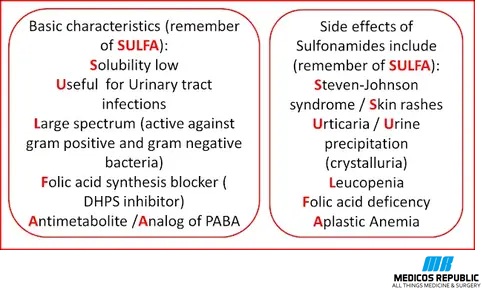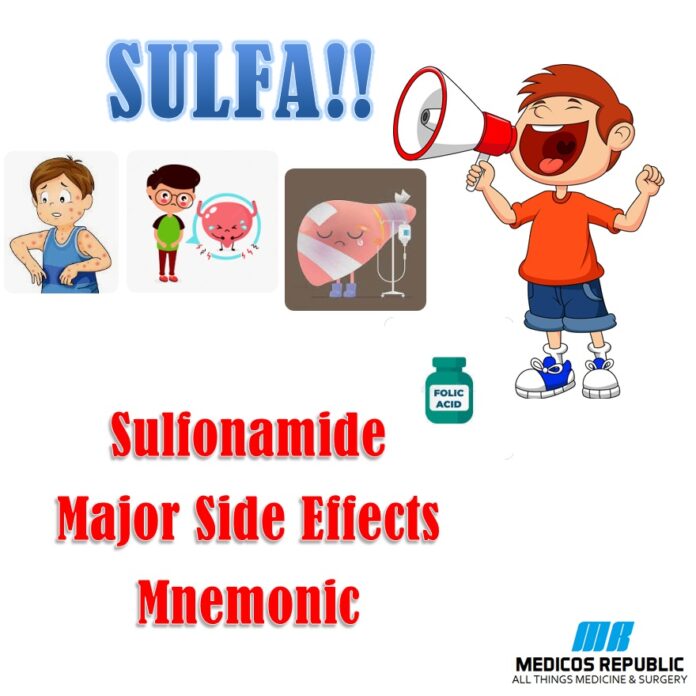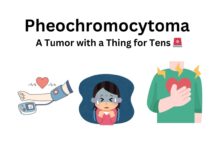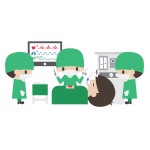Sulfonamides are a class of drugs that are used to treat a wide range of bacterial infections. While Sulfonamides can be very effective, they can also have some serious side effects that need to be monitored carefully. One way to remember the major side effects of sulfonamides is to use a mnemonic. In this blog post, we’ll explore a fun and easy-to-remember mnemonic for sulfonamide side effects. 🙂
The mnemonic for sulfonamide side effects is “SULFA” – it’s short, sweet, and easy to remember. Here’s what it stands for:
It’s called “SULFA” and it stands for:
S – Skin reactions
U – Urinary tract problems
L – Liver damage
F – Folic acid deficiency
A – Allergic reactions
Let’s break it down a bit further.
S – Skin reactions / Steven-Johnson syndrome: Sulfonamides are known to cause various skin reactions, including rashes, hives, and photosensitivity. These reactions can range from mild to severe and therefore, should be monitored closely. Sulfonamides can also cause a rare and serious skin reaction called Steven-Johnson syndrome (toxic epidermal necrolysis)
U – Urinary tract problems: Sulfonamides can cause damage to kidneys and can cause urinary tract problems. Symptoms of these problems include blood in the urine (hematuria), painful urination, and frequent urination.
L – Liver damage: Sulfonamides can also cause potential liver damage, leading to jaundice, fatigue, and abdominal pain.
F – Folic acid deficiency: Sulfonamides can interfere with the body’s ability to absorb folic acid, which can lead to anemia, fatigue, and other symptoms.
A – Allergic reactions: Finally, sulfonamides can cause allergic reactions in some people. These reactions can range from mild to severe and can include symptoms such as hives, difficulty breathing, and swelling of the face or throat.

Another Sulfonamide Mnemonic: 🙂
Sulfonamide: Major Side Effects
Mnemonic: S-S-S-S
- Steven-Johnson syndrome
- Skin rash
- Solubility low (causes crystalluria)
- Serum albumin displaced (Causes newborn kernicterus and potentiation of other serum albumin binders like warfarin)
Happy learning! 🙂





![Carcinoid Syndrome Mnemonic [Easy-to-memorize] Carcinoid Syndrome Mnemonic](https://www.medicosrepublic.com/wp-content/uploads/2024/08/Carcinoid-Syndrome-Mnemonic-Easy-to-memorize-218x150.jpg)

![Stages of Neurocysticercosis Mnemonic [Vegans Can’t Get Neurocysticercosis] Stages of Neurocysticercosis Mnemonic](https://www.medicosrepublic.com/wp-content/uploads/2023/08/Stages-of-Neurocysticercosis-Mnemonic-Vegans-Cant-Get-Neurocysticercosis-1-218x150.jpg)
![Hale’s Medications & Mothers’ Milk™ 2019 18th Edition PDF Free Download [Direct Link] Hale's Medications & Mothers' Milk™ 2019 18th Edition PDF](https://www.medicosrepublic.com/wp-content/uploads/2018/12/Hales-Medications-Mothers-Milk™-2019-18th-Edition-PDF-Free-Download-150x150.jpg)
![Surgical Anatomy of the Head and Neck PDF Free Download [Direct Link]](https://www.medicosrepublic.com/wp-content/uploads/2022/06/Surgical-Anatomy-of-the-Head-and-Neck-PDF-Free-Download-696x365-1-150x150.jpg)
![Anatomy for Anaesthetists 9th Edition PDF Free Download [Direct Link]](https://www.medicosrepublic.com/wp-content/uploads/2019/03/Anatomy-for-Anaesthetists-9th-Edition-PDF-Free-Download-150x150.jpg)
![Gray’s Surface Anatomy and Ultrasound PDF Free Download [Direct Link] Gray’s Surface Anatomy and Ultrasound 1st Edition PDF](https://www.medicosrepublic.com/wp-content/uploads/2018/07/Gray’s-Surface-Anatomy-and-Ultrasound-PDF-Free-Download-150x150.jpg)
![Harrisons Principles of Internal Medicine Self-Assessment and Board Review 18th Edition PDF Free Download [Direct Link] Harrisons Principles of Internal Medicine Self-Assessment and Board Review 18th Edition PDF](https://www.medicosrepublic.com/wp-content/uploads/2022/10/Harrisons-Principles-of-Internal-Medicine-Self-Assessment-and-Board-Review-18th-Edition-PDF-Free-Download-150x150.jpg)
![Critical Observations in Radiology for Medical Students 1st Edition PDF Free Download [Direct Link] Critical Observations in Radiology for Medical Students PDF Free Download PDF](https://www.medicosrepublic.com/wp-content/uploads/2018/06/Critical-Observations-in-Radiology-for-Medical-Students-PDF-Free-Download-150x150.jpg)
![Briggs Drugs in Pregnancy and Lactation 12th Edition PDF Free Download [Direct Link] Briggs Drugs in Pregnancy and Lactation 12th Edition PDF](https://www.medicosrepublic.com/wp-content/uploads/2022/08/Briggs-Drugs-in-Pregnancy-and-Lactation-12th-Edition-PDF-Free-Download-150x150.jpg)
![Optimal Pain Management for the Dental Team 1st Edition PDF Free Download [Direct Link]](https://www.medicosrepublic.com/wp-content/uploads/2023/06/Optimal-Pain-Management-for-the-Dental-Team-1st-Edition-1-150x150.jpg)
![Obstetrics and Gynecology Board Review Pearls of Wisdom 4th Edition PDF Free Download [Direct Link] Obstetrics and Gynecology Board Review Pearls of Wisdom 4th Edition PDF](https://www.medicosrepublic.com/wp-content/uploads/2022/11/Obstetrics-and-Gynecology-Board-Review-Pearls-of-Wisdom-4th-Edition-PDF-Free-Download-150x150.jpg)
![Lippincott Biochemistry 6th Edition PDF Free Download [Direct Link] Lippincott's Illustrated Reviews Biochemistry 6th Edition PDF](https://www.medicosrepublic.com/wp-content/uploads/2017/11/Lippincott-Biochemistry-6th-Edition-PDF-Free-Download-150x150.jpg)




